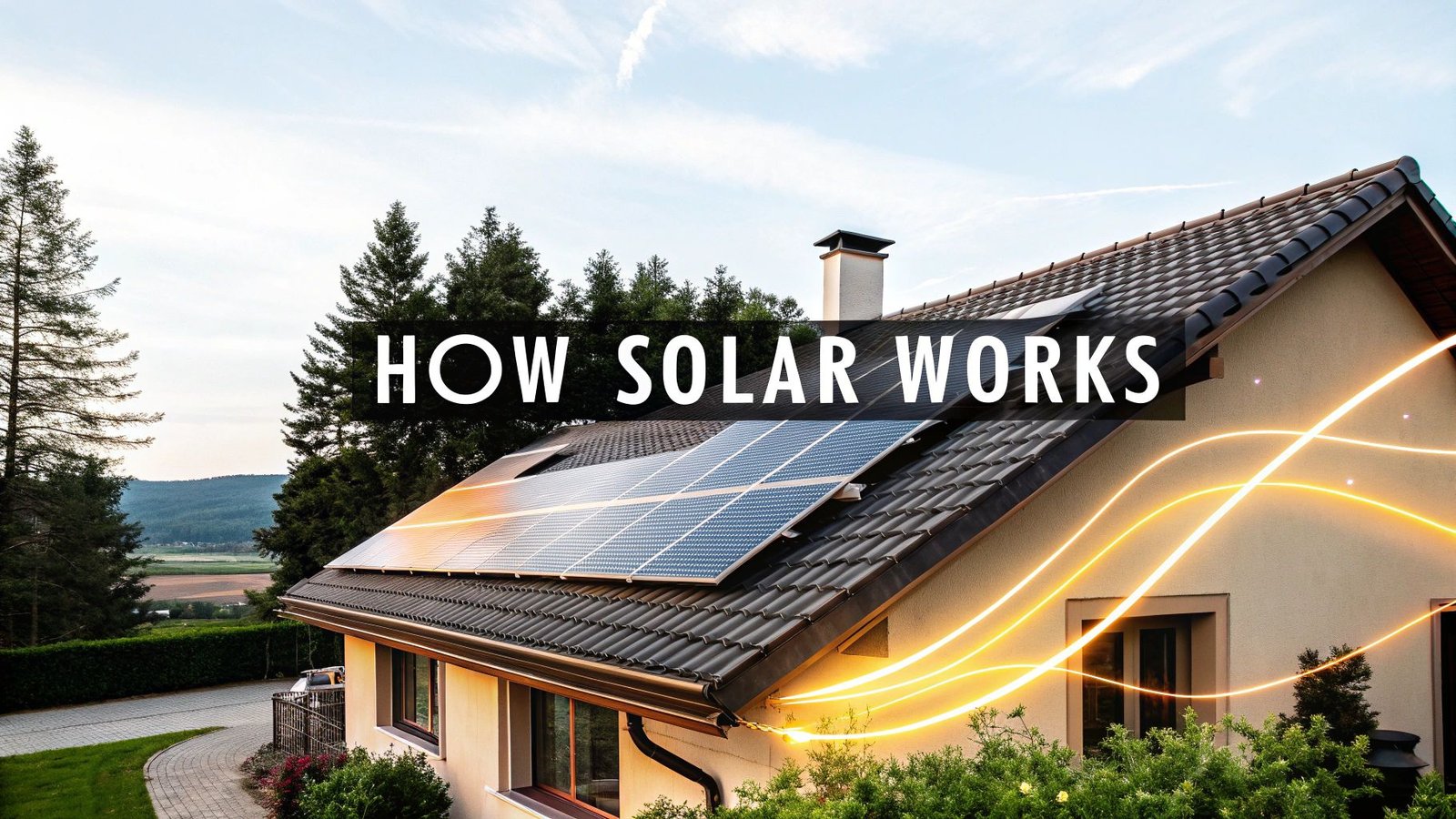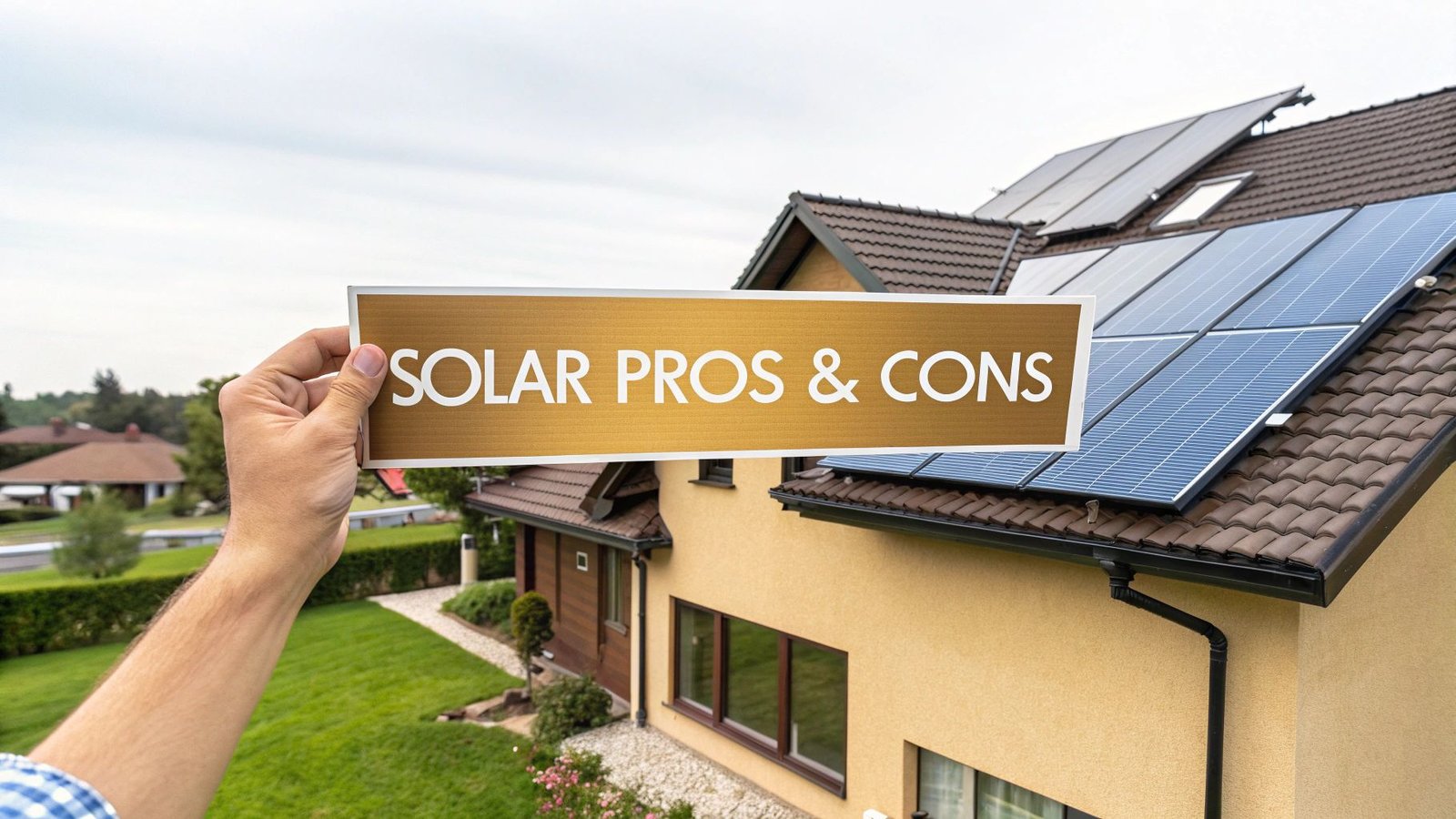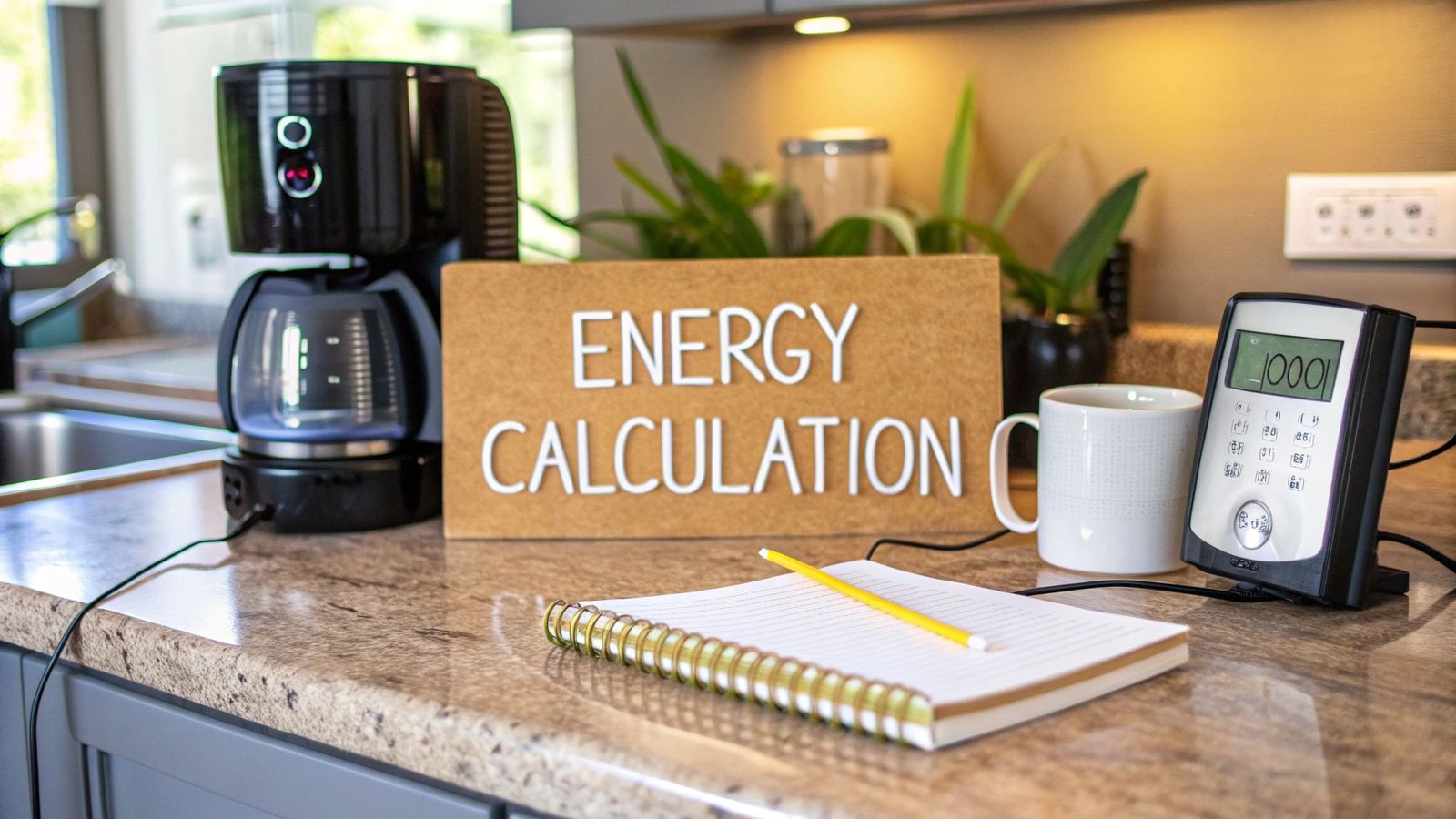Thinking about how home solar works can feel a bit technical, but the core idea is surprisingly straightforward. Your solar panels are essentially turning pure sunlight into the electricity you use every day, letting you power your appliances with the sun. This all happens quietly up on your roof, cutting down your dependence on the traditional power grid.
How Sunlight Becomes Your Home's Electricity
At its heart, a home solar system is your own personal power plant. Think of your solar panels like the leaves on a tree. Just as leaves capture sunlight to create energy for the tree, your panels catch sunlight to generate electrical energy for your home. It’s a clean, quiet, and remarkably efficient process that plays out in a few key steps.
This whole journey, from a sunbeam hitting your roof to you flicking on a light switch, is driven by a neat bit of science called the photovoltaic effect. It's the magic that makes solar power possible in the first place.
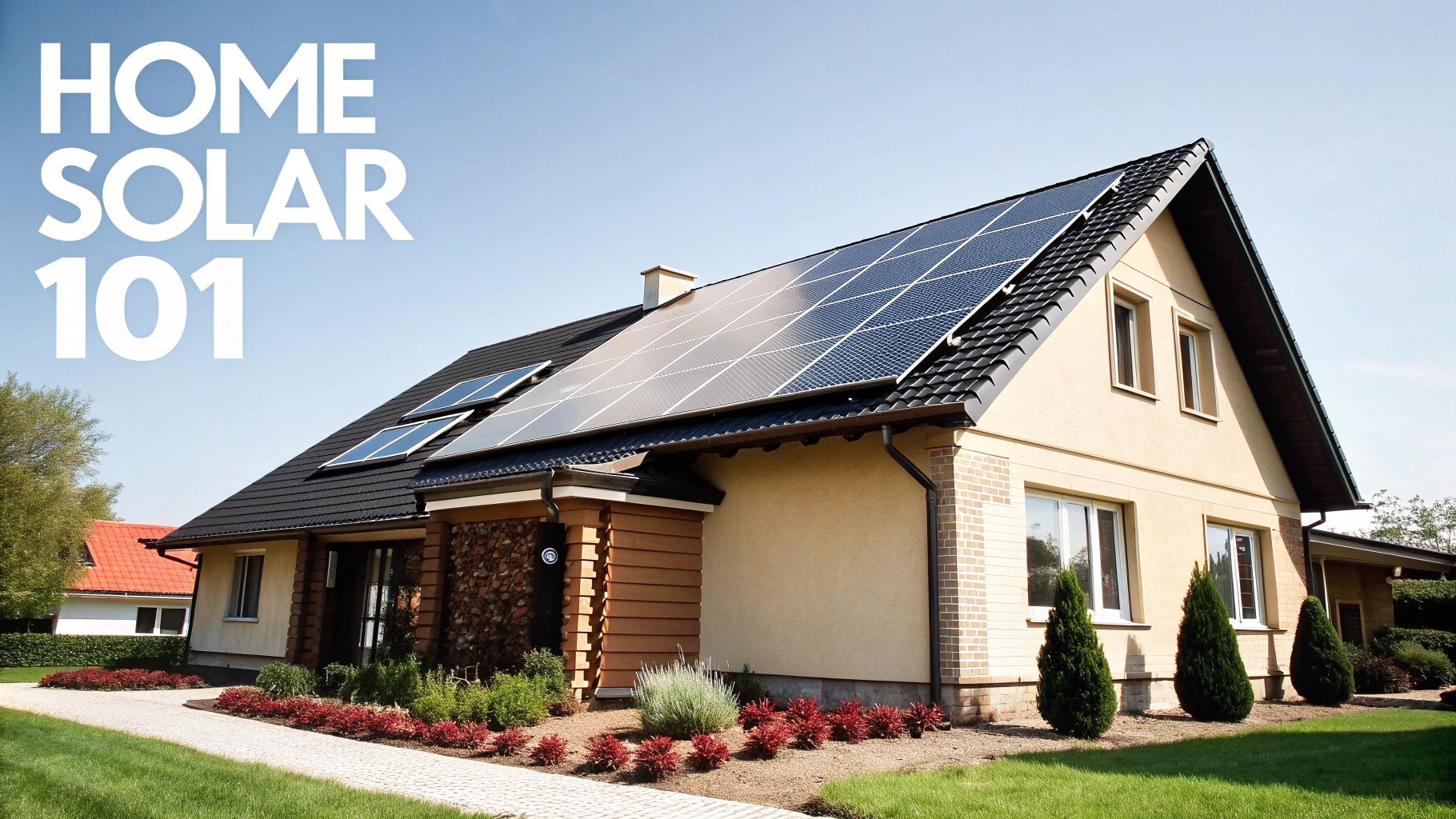
The Photovoltaic Effect in Action
So, how does this actually work? Home solar systems convert sunlight into electricity using photovoltaic (PV) panels, which you'll typically see mounted on a roof. These panels are packed with semiconductor materials, most often silicon.
When photons from sunlight hit the silicon, they knock electrons loose, creating a direct current (DC) of electricity. The catch is, your home runs on alternating current (AC). That’s where an inverter comes in—it’s a critical piece of the puzzle that converts the raw DC electricity into the AC power your house can use.
Thanks to constant innovation, today's solar inverters and panels are more efficient than ever. The chart below shows the steady rise in efficiency over the years.
{
"type": "line",
"data": {
"labels": ["2010", "2015", "2020", "2024"],
"datasets": [{
"label": "Average Panel Efficiency",
"data": [15, 17, 19, 21],
"borderColor": "rgba(255, 206, 86, 1)",
"backgroundColor": "rgba(255, 206, 86, 0.2)",
"fill": true
}]
},
"options": {
"scales": {
"y": {
"beginAtZero": false,
"ticks": { "callback": "(value) => value + '%'" }
}
},
"plugins": {
"title": { "display": true, "text": "Evolution of Solar Panel Efficiency" }
}
}
}
Many now convert sunlight with an efficiency of over 20%. It’s pretty amazing to see how far the technology has come. If you're curious about the bigger picture, you can learn more about recent trends in the global solar market and see how this tech is evolving worldwide.
Key Takeaway: Your solar system doesn't create energy out of thin air. It simply converts one form of energy (sunlight) into another (electricity) that your home can use.
Best of all, this conversion is completely seamless and automatic. You don’t need to flip any special switches; the system is smart enough to manage the entire energy flow for you.
From Sunshine to Socket A Quick Overview
Breaking down the process step-by-step makes it much easier to understand how it all comes together. The table below traces the journey of energy from the sun right to your electrical outlet.
| Step | What Happens | Key Component |
|---|---|---|
| 1. Sunlight Absorption | Photons in sunlight strike the solar panels, exciting electrons within the silicon cells. | Solar Panels |
| 2. DC Electricity Generation | The movement of these excited electrons creates a flow of direct current (DC) electricity. | Solar Panels |
| 3. Power Conversion | An inverter converts the raw DC electricity into alternating current (AC) power. | Inverter |
| 4. Power Distribution | The usable AC power flows through your home's electrical panel to power your lights and appliances. | Electrical Panel |
From absorption to distribution, these four steps happen continuously whenever the sun is shining, giving you a steady stream of clean power for your home.
The Core Components of Your Home Solar System
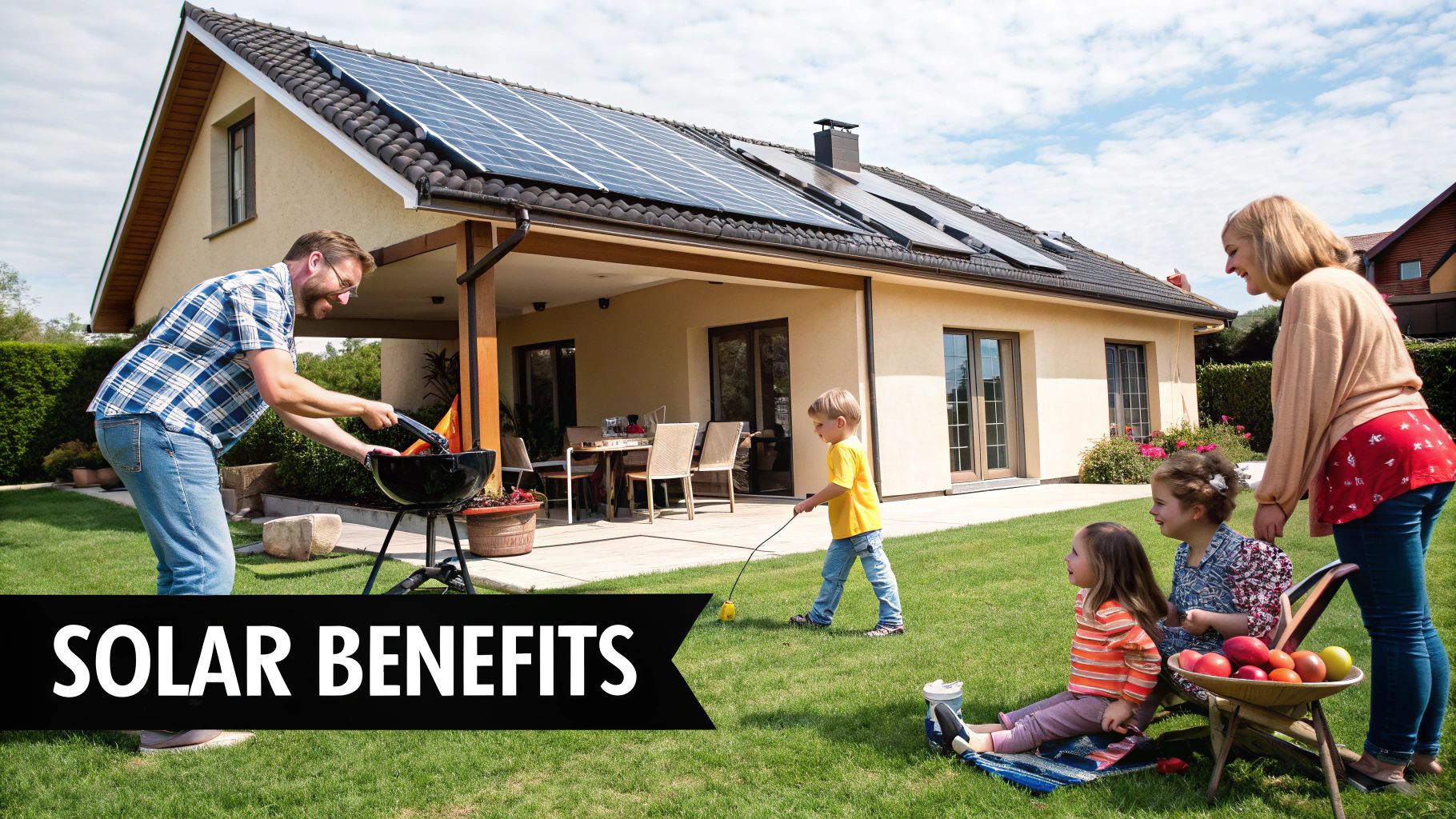
To really get how home solar works, you need to know about the key pieces of equipment that make it all happen. While the panels on your roof get all the attention, a full solar setup is actually a team of components working together to turn raw sunlight into the power you use every day. Think of it as your own personal power plant, where each part has a vital job to do.
At its heart, a residential solar system has four main players: the solar panels catching the sun, an inverter making the power usable, the racking holding it all down, and an optional battery for storing extra energy. Let’s take a closer look at what each one brings to the table.
The Solar Panels: The Engine of Your System
Photovoltaic (PV) panels are the workhorses of your solar energy system. These are the dark, sleek rectangles on your roof that do the heavy lifting of capturing sunlight. Inside each panel are dozens of smaller solar cells, usually made from silicon, that perform the incredible trick we know as the photovoltaic effect.
When sunlight hits these cells, it knocks electrons loose and creates an electrical current. This initial power is direct current (DC) electricity—great for charging a phone, but not what your home's appliances run on. The quality and efficiency of your panels are everything; they determine just how much electricity your system can squeeze out of the sun's rays. Today, most home installations rely on highly efficient monocrystalline panels to maximize production.
The Inverter: The Brains of the Operation
If solar panels are the engine, then the inverter is the brain. This smart device is the crucial middleman that takes the raw DC power from your panels and converts it into alternating current (AC) electricity. AC power is the universal standard for everything plugged into your walls, from the microwave to your laptop charger. Without an inverter, the power your panels generate would be completely unusable.
There are a few different types of inverters, and the one you choose will impact your system's performance, how you monitor its output, and the overall cost.
Inverter Technology Compared
| Inverter Type | How It Works | Best For |
|---|---|---|
| String Inverter | A single, central inverter connects a "string" of panels, converting their combined DC output into AC power all at once. | Simple, unshaded roofs where all panels face the same direction. This is usually the most budget-friendly option. |
| Microinverters | A small inverter is attached to the back of every single panel, converting DC to AC right at the source. | Complex roofs with different angles or spots that get shade, since one underperforming panel won't drag down the rest. |
| Power Optimizers | A hybrid solution. Optimizers are put on each panel to condition the DC power before sending it to one central inverter. | Gives you panel-level benefits like microinverters but often at a better price point. It's a great middle-ground choice. |
The Mounting System: The Skeleton
The mounting system, also known as racking, is the unsung hero of any solar installation. It's the sturdy skeleton that secures the panels to your roof, making sure they can stand up to high winds, heavy rain, and piles of snow for decades to come. You can’t overstate the importance of a well-installed racking system for the safety and lifespan of your investment.
This metal framework is also carefully engineered to hold your panels at the perfect angle to soak up the most sun. Plus, it creates a small air gap between the panels and your roof, which helps keep the panels cool so they can operate at peak efficiency.
The Solar Battery: The Energy Pantry (Optional)
A solar battery is an optional add-on, but it's quickly becoming a game-changer for homeowners. The best way to think of it is as an energy pantry for your house. During the day, if your panels are making more electricity than you're using, the extra power goes into the battery to be stored instead of being sold back to the grid.
Storing your own solar energy gives you power security. When the sun goes down or a power outage occurs, your home can seamlessly switch to using the clean energy stored in your battery.
You can then pull from that stored energy at night, on overcast days, or—most importantly—during a power outage. Adding a battery is the key to achieving true energy independence. It cuts your reliance on the utility company and provides priceless peace of mind. While it does increase the upfront cost, a battery ensures you get full value from every single kilowatt-hour your panels produce.
Understanding Your Connection to the Power Grid
When you go solar, your home doesn't just cut ties with your local utility company. Instead, you enter into a new, dynamic relationship with the public power grid. This connection is what makes modern solar so practical, giving you the best of both worlds: clean, self-generated power and the reliability of the grid.
Think of it this way: your home transforms from a simple energy consumer into an active participant in the energy market.
This all works because of a brilliant concept called net metering. The easiest way to picture it is to think of the utility grid as a giant energy bank. On bright, sunny afternoons when your panels are cranking out more electricity than you can use, you "deposit" that extra power into the grid. Your utility company keeps a running tab of these deposits, giving you credits on your bill.
Then, at night or on a cloudy day when your panels aren't producing, you simply "withdraw" power from the grid just like you always have. The credits you earned earlier are automatically applied to cover the cost of the power you use. It's a seamless give-and-take that ensures you're never without power and that you get full value for every bit of energy your panels generate.
This infographic breaks down how sunlight, panel efficiency, and your home's usage all come together to determine your daily energy flow.
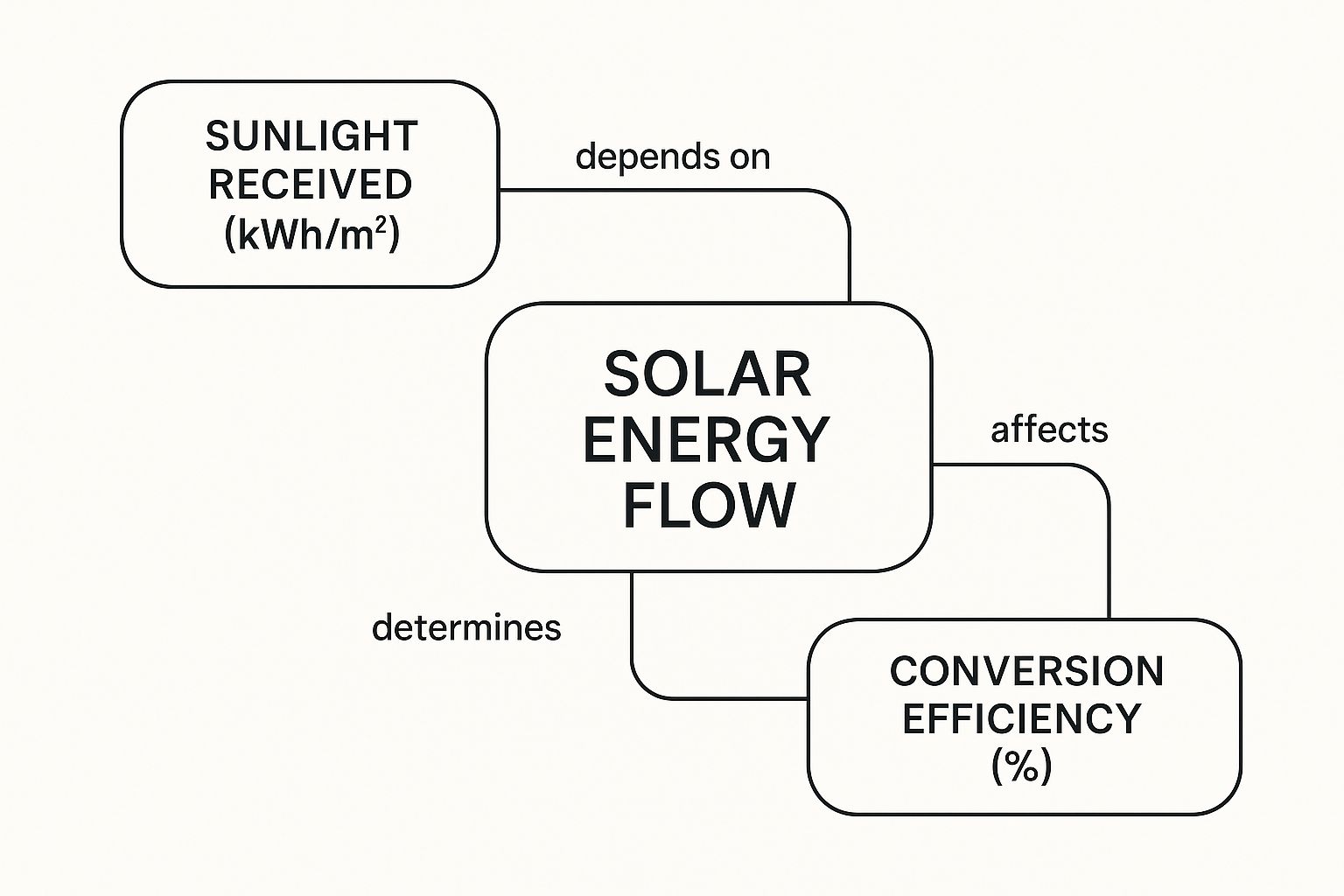
The big takeaway here is that your home’s energy output isn’t static. It flexes based on how much sun you’re getting and how efficiently your system converts that sunlight into usable power. That balance determines whether you’re using your own energy, sending it to the grid, or pulling power back.
The Three Types of Solar Connections
Not all solar installations are created equal. Homeowners generally choose from three primary setups, and the right one for you really boils down to your location, budget, and what you want to achieve with solar.
{
"type": "pie",
"data": {
"labels": ["Grid-Tied", "Hybrid", "Off-Grid"],
"datasets": [{
"data": [85, 13, 2],
"backgroundColor": ["#FFCE56", "#4BC0C0", "#FF6384"],
"hoverBackgroundColor": ["#FFCE56", "#4BC0C0", "#FF6384"]
}]
},
"options": {
"plugins": {
"title": { "display": true, "text": "Common Home Solar System Types by Popularity" },
"tooltip": { "callbacks": { "label": "(context) => context.label + ': ' + context.raw + '%'" } }
}
}
}
- Grid-Tied Systems: This is the most popular setup by far. Your system is tied directly to the public grid, letting you take full advantage of net metering. It's simple, effective, and doesn't require the added expense of batteries.
- Off-Grid Systems: Just like the name implies, these systems are completely disconnected from the utility grid. They’re a fantastic solution for remote properties where connecting to the grid is impossible or incredibly expensive, but they require a sizable battery bank to keep the lights on.
- Hybrid Systems: A hybrid setup offers the best of both worlds. You’re still connected to the grid, but you also have a solar battery. This lets you store your own excess energy for later use, provides backup power during an outage, and still gives you the grid as a final failsafe.
Key Takeaway: Deciding on your system type is one of the most important choices you'll make. Grid-tied systems are all about maximizing your financial return, while hybrid systems add a powerful layer of energy security with battery backup.
A Deeper Dive Into System Choices
The choice between a grid-tied, off-grid, or hybrid system isn't just about the technology—it's about your lifestyle and financial goals. The incredible growth in home solar shows just how many people are making this decision. In a recent single year, the world added nearly 600 GW of new solar capacity, marking a 33% annual jump. This boom, which pushed global capacity past 2.2 TW, is being fueled in a big way by homeowners like you. You can see the full scope of this trend by reading the latest analysis on solar energy statistics.
To help you figure out which path makes sense for you, let’s compare the three main configurations side-by-side.
Grid-Tied vs Off-Grid vs Hybrid Solar: A Comparison
Choosing the right solar setup is crucial for meeting your energy goals. This table offers a side-by-side look at the three main types of solar configurations to help you decide which is the best fit for your home and lifestyle.
| System Type | Grid Connection | Best For | Key Advantage |
|---|---|---|---|
| Grid-Tied | Fully connected | Homeowners in areas with reliable grids and strong net metering policies. | Lowest upfront cost and fastest return on investment. |
| Off-Grid | Not connected | Remote homes where grid access is unavailable or prohibitively expensive. | Complete energy independence and no monthly utility bills. |
| Hybrid | Connected with battery backup | Homeowners wanting energy security during outages and greater self-sufficiency. | Uninterrupted power during blackouts and optimized use of solar energy. |
Ultimately, choosing a system depends on your priorities—whether that's saving money, gaining independence, or ensuring you're never left in the dark.
At the end of the day, understanding how home solar works means seeing your house as its own mini power hub. Whether you're sending extra electricity back to your neighbors or banking it in a battery for a rainy day, your system is now an active, contributing part of the modern energy grid.
The Real Financial and Environmental Rewards of Solar
Okay, the technology is impressive, but let's get down to what really matters: what’s in it for you? When you decide to go solar, you're not just making a choice about where your electricity comes from. You're making a savvy financial move that pays you back for years while also doing something genuinely good for the planet.
The first thing you'll notice is the immediate relief on your monthly utility bill. By generating your own power right on your rooftop, you drastically cut down on how much electricity you have to buy from the grid. For many homeowners, this adds up to $1,500 or more in savings every single year, though that figure can change based on your local power costs and how much sun your panels soak up.
This also means you're stepping off the rollercoaster of unpredictable energy prices. While your utility company's rates can, and often do, climb without warning, the cost of your solar power is fixed. That kind of stability and predictability in your monthly budget is a huge win.
Unlocking Long-Term Financial Value
The financial perks of a home solar system go way beyond just the monthly savings. Think of it as a home improvement that actually pays for itself over time and boosts your property's marketability.
A 2024 study found something remarkable: homes with solar panels sell for 6.9% more on average than similar homes without them. It’s a smart upgrade that builds real equity.
This added home value is fantastic, but the financial picture gets even better. The biggest catalyst for many homeowners is the federal Residential Clean Energy Credit. This incentive lets you subtract 30% of the total cost of your solar installation directly from what you owe on your federal taxes. It’s a massive discount that makes the upfront investment much more manageable.
Let’s see what that 30% tax credit looks like in practice:
| Initial System Cost | 30% Federal Tax Credit | Final Cost After Credit |
|---|---|---|
| $18,000 | $5,400 | $12,600 |
| $25,000 | $7,500 | $17,500 |
| $32,000 | $9,600 | $22,400 |
When you combine that powerful tax credit with years of energy savings, most solar systems pay for themselves in less than a decade. Once you hit that "payback period," every single watt of energy your panels produce is pure, free electricity.
On a larger scale, the boom in home solar is a massive economic force. The global market for solar energy systems was valued at around USD 296.77 billion in 2025 and is expected to skyrocket. This chart visualizes that explosive growth.
{
"type": "bar",
"data": {
"labels": ["2025", "2034"],
"datasets": [{
"label": "Global Solar Market Value (Billion USD)",
"data": [296.77, 1146.25],
"backgroundColor": ["rgba(75, 192, 192, 0.6)", "rgba(54, 162, 235, 0.6)"],
"borderColor": ["rgba(75, 192, 192, 1)", "rgba(54, 162, 235, 1)"],
"borderWidth": 1
}]
},
"options": {
"scales": { "y": { "beginAtZero": true } },
"plugins": {
"title": { "display": true, "text": "Projected Growth of Solar Energy Systems Market" }
}
}
}
This incredible growth, driven by smart policies and more affordable tech, shows just how much confidence the world has in solar. You can discover more about the growing solar market to see the full forecast.
The Tangible Environmental Impact
Going solar is also a powerful personal statement about your commitment to a healthier planet. Every kilowatt-hour of clean energy from your roof is one less that needs to be generated by a fossil-fuel power plant. That directly shrinks your family’s carbon footprint.
But what does that really mean? The positive impact is bigger than you might think. Let's translate it into real-world terms:
- Like Planting a Forest: Over its 25-year lifespan, a standard residential solar system prevents the same amount of CO2 as planting over 150 acres of trees.
- Cleaner Roads: The clean power it generates is equivalent to taking more than 35 cars off the road for a full year.
- Less Fossil Fuel: It offsets the need to burn over 165,000 pounds of coal.
These aren't just abstract numbers. They show that your individual choice creates a ripple effect, leading to cleaner air, healthier communities, and a more sustainable world for everyone. It's a personal action with a truly collective benefit.
Your Solar Installation Journey Step by Step
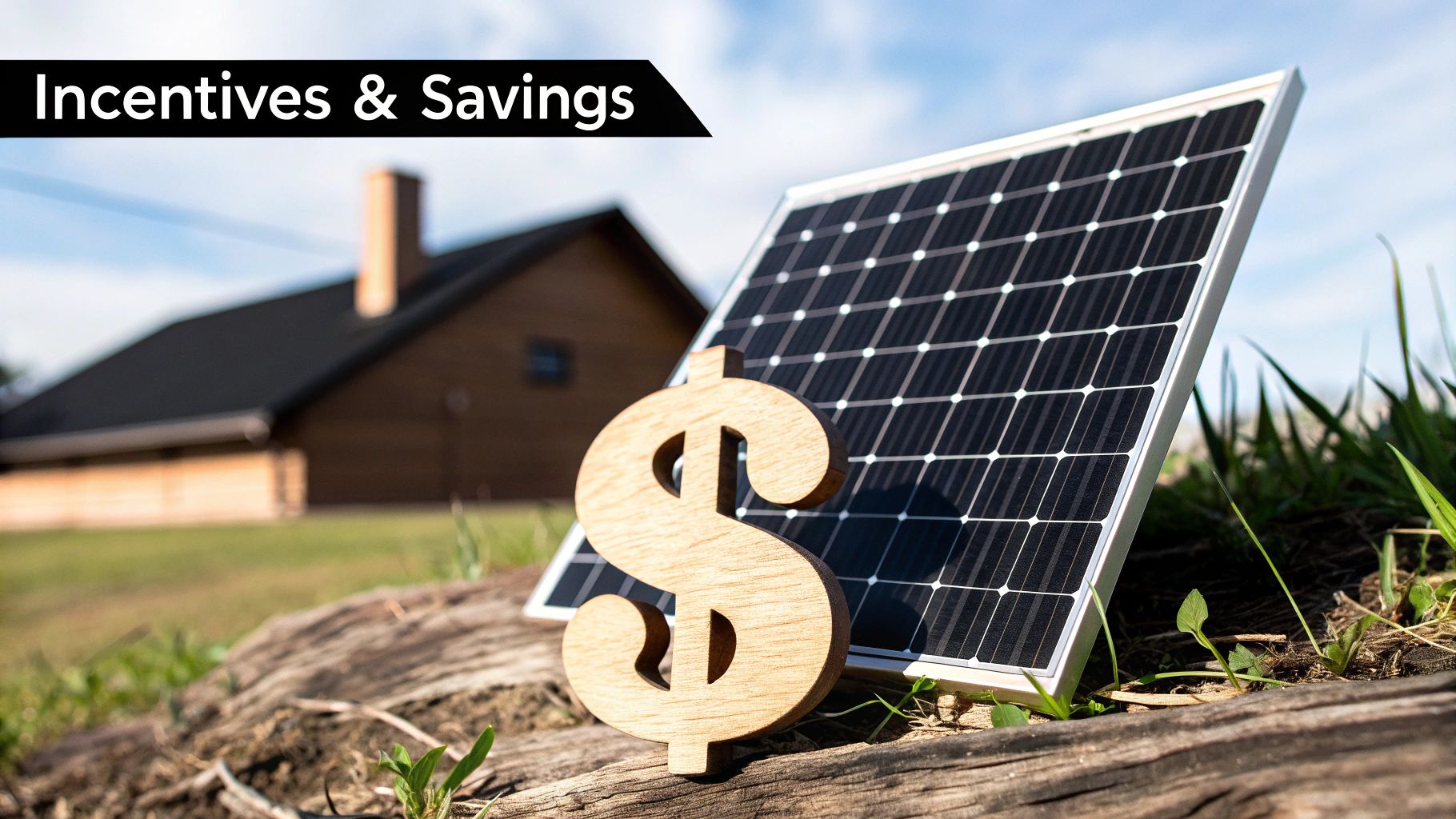
So, you've decided to go solar. That’s a big, exciting decision! But what actually happens between saying "yes" and flipping the switch on your own personal power plant? It might seem like a complex mystery, but it's really a straightforward process with clear, well-defined stages.
Knowing what to expect takes the guesswork out of the equation. It helps you see exactly how your investment turns into a real, working system on your roof, ready to power your home with clean energy. Let's walk through the entire journey, from that first chat to the moment your meter starts spinning backward.
Stage 1: The Initial Chat and Site Check-Up
Your journey begins with a simple conversation. You’ll sit down with a solar professional to talk about what you want to achieve—are you looking to slash your electric bill, go green, or both? They'll want to see your past energy bills to understand your usage and discuss your budget. This isn't just a sales pitch; it’s a discovery session to make sure solar is the right fit for you and your home.
Next up is the site assessment. This is where a technician gets up close and personal with your property, either in person or through advanced satellite imaging, to see if it’s a good candidate for solar panels. They’ll be looking at a few key things:
- The age and overall health of your roof.
- How much usable space you have and which direction it faces (south is the sweet spot!).
- Any pesky shadows from trees, chimneys, or that tall new house next door.
- Your main electrical panel, to make sure it can handle the extra power.
Think of this as gathering the raw ingredients. This information is absolutely critical for designing a system that’s built specifically for your home and gives you the best possible performance.
Stage 2: System Design and the Waiting Game (Permitting)
With all that data from the site assessment, the engineers get to work. They’ll create a custom blueprint for your home, showing exactly where each panel will go, where the inverter will be mounted, and how everything will be wired together. The goal is simple: squeeze every last watt of energy out of your system while staying on the right side of all local building and electrical codes.
Once you give the design a thumbs-up, the real waiting begins. This is the permitting phase. Your solar installer will handle all the tedious paperwork, submitting the plans to your local city or county and the utility company. Honestly, this can be the longest part of the whole process, sometimes taking weeks or even a few months, depending on how quickly your local authorities move.
Key Insight: Don't be surprised if permitting takes longer than the actual installation. While the crew can get the panels up in a day or two, getting the official green light from the powers that be just takes time and patience.
Stage 3: Installation Day!
This is where the magic happens. With all the permits approved, the installation crew shows up to bring your solar system to life. It’s a surprisingly fast and organized process.
- Mounting the Racking: First, the crew installs a super-sturdy metal framework on your roof. This is the foundation that will hold your panels securely in place for decades.
- Setting the Panels: Next, they carefully lift and attach each solar panel onto the racking system.
- Wiring It All Up: The team then wires the panels together and runs the electrical lines down to where your inverter will live.
- Connecting the Brains: Finally, they mount the inverter and connect it to both the solar array and your home’s main electrical panel.
For most homes, the entire hands-on installation is finished in just one to two days. Professional installers are experts at working quickly and cleanly, causing minimal disruption to your daily life.
Stage 4: The Final Inspections and Powering On
The panels are up, but you're not quite done. An inspector from your local building department needs to come out and give the system a final look-over. They’re just making sure everything was installed safely and according to code.
After you pass that inspection, the utility company does its own final review. Once they're satisfied, they grant you Permission to Operate (PTO). This is the official go-ahead you’ve been waiting for. It means your system is now formally connected to the grid, and you can finally start generating your own clean, renewable electricity.
Common Questions About Living with Solar
Even after you understand the nuts and bolts of how solar works, some practical questions always pop up. It’s only natural. Going solar is a major home upgrade, and you want to be completely sure you know what to expect day-to-day.
Let's walk through the most common concerns I hear from homeowners. We'll tackle everything from performance on gray days to long-term durability, clearing up any lingering doubts you might have.
What Happens on Cloudy Days or at Night?
This is probably the number one question people ask. It’s a good one. While solar panels absolutely love direct sunlight, they don't just give up on overcast days. They still produce power, just less of it. Think of it like a dimmer switch—cloud cover simply turns down the production level for a while.
So, how do your lights stay on? Your home is smart enough to pull power from the utility grid automatically whenever it needs to. The switch between your solar power and grid power is completely seamless and instantaneous. You won't even notice it happening. At night, or during a really heavy storm, you'll rely entirely on the grid, just like you always have.
If you decide to add a solar battery to your system, your home will tap into that stored energy first before ever turning to the grid. This helps you get the most out of every bit of clean energy you generate.
The Bottom Line: A grid-tied solar system means you're never without power. Your panels do the heavy lifting when the sun is out, and the grid acts as a reliable, automatic backup whenever you need it.
This table gives you a simple look at how a home with solar typically uses energy throughout the day.
| Time of Day | Primary Power Source | What's Happening |
|---|---|---|
| Morning (Sunny) | Solar Panels | Panels wake up and start powering your home. |
| Afternoon (Peak Sun) | Solar Panels & Grid | You're making more power than you need, so the extra goes to the grid for credit. |
| Evening (Sunset) | Utility Grid | The panels go to sleep, and your home draws power from the grid. |
| Overcast Day | Solar Panels & Grid | Panels are still working, but the grid steps in to cover the rest. |
How Much Maintenance Do Solar Panels Need?
Honestly, one of the best things about modern solar technology is how little you have to think about it. Solar panels are built tough, with no moving parts to wear out or break down. They're designed to sit on your roof and quietly do their job for decades.
For the most part, they even clean themselves. A good rainstorm is usually all it takes to wash off the dust, pollen, and grime that can build up. If you live in a particularly dry or dusty area, a quick rinse with a garden hose once or twice a year is more than enough to keep them working at their best.
While you won't be doing much yourself, it’s a good idea to have a professional look over the system every few years. They'll just make sure the inverter, wiring, and all the connections are still in perfect shape. All in all, you can expect your panels to operate reliably for decades with next to no effort on your part.
How Long Will My Solar System Last?
When you invest in a home solar system, you're playing the long game. Thankfully, the equipment is built for it. The solar panels themselves are incredibly resilient. Most manufacturers back them with a 25-year performance warranty, guaranteeing they will still produce at least 80-90% of their original power after a quarter-century.
The inverter is the real workhorse of the system, and it typically has a shorter lifespan, usually around 10 to 15 years. You'll likely need to replace it once during the lifetime of your panels.
Put it all together, and you can confidently expect your solar system to generate clean energy for 25 to 30 years, and often even longer. It’s an investment designed to pay for itself many times over.
Is My Roof Suitable for Solar Panels?
Most residential roofs are great candidates for solar, but we always need to confirm. A few key factors determine whether your roof is a good fit.
A professional installer will do a full assessment, either by visiting your home or using high-resolution satellite imagery, to check these key points:
- Roof Condition: Your roof needs to be in good shape, with no damage or leaks. If it’s getting old, it's always smarter to replace it before the panels go on.
- Orientation and Angle: The dream scenario is a big, south-facing roof with no obstructions. But don't worry—east and west-facing roofs are also fantastic for generating power all day long.
- Shading: We’ll look for anything that could cast a shadow on your panels, like a tall tree or a chimney. Even a little bit of shade can impact production, so we plan around it.
We'll also look at your past electricity bills to design a system that’s the perfect size for your family's needs. This custom-fit approach is what ensures you get the absolute best return on your solar investment.
Ready to see if your home is a perfect fit for solar? At Radiant Energy, we provide high-quality solar energy solutions to give you energy independence and a cleaner future. From system design to installation and maintenance, we handle every step with precision. Find out how much you could save by exploring our solar solutions.
Article created using Outrank

